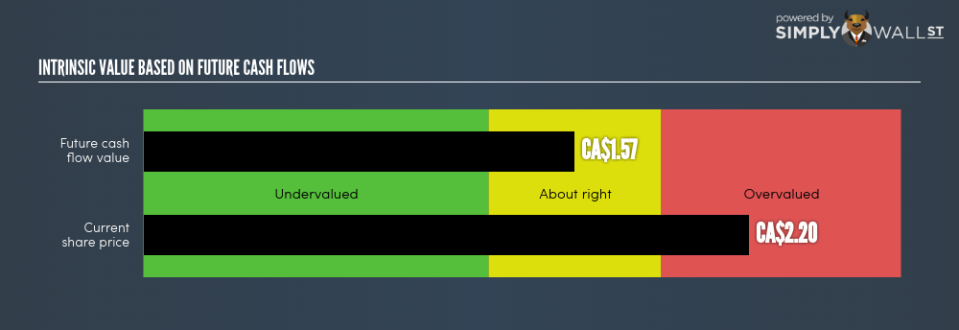Intrinsic Calculation For Argonaut Gold Inc (TSE:AR) Shows Investors Are Overpaying

Does the share price for Argonaut Gold Inc (TSE:AR) reflect it’s really worth? Today, I will calculate the stock’s intrinsic value by projecting its future cash flows and then discounting them to today’s value. I will use the discounted cash flows (DCF) model. Don’t get put off by the jargon, the math behind it is actually quite straightforward. Anyone interested in learning a bit more about intrinsic value should have a read of the Simply Wall St analysis model. Please also note that this article was written in June 2018 so be sure check out the updated calculation by following the link below. View out our latest analysis for Argonaut Gold
The model
I’m using the 2-stage growth model, which simply means we take in account two stages of company’s growth. In the initial period the company may have a higher growth rate and the second stage is usually assumed to have perpetual stable growth rate. In the first stage we need to estimate the cash flows to the business over the next five years. Where possible I use analyst estimates, but when these aren’t available I have extrapolated the previous free cash flow (FCF) from the year before. For this growth rate I used the average annual growth rate over the past five years, but capped at a reasonable level. The sum of these cash flows is then discounted to today’s value.
5-year cash flow forecast
2018 | 2019 | 2020 | 2021 | 2022 | |
Levered FCF ($, Millions) | $19.73 | $58.00 | $35.00 | $33.52 | $32.10 |
Source | Analyst x6 | Analyst x4 | Analyst x1 | Extrapolated @ (-4.23%) | Extrapolated @ (-4.23%) |
Present Value Discounted @ 17.48% | $16.80 | $42.03 | $21.59 | $17.60 | $14.35 |
Present Value of 5-year Cash Flow (PVCF)= CA$112.35m
The second stage is also known as Terminal Value, this is the business’s cash flow after the first stage. The Gordon Growth formula is used to calculate Terminal Value at an annual growth rate equal to the 10-year government bond rate of 2.3%. We discount this to today’s value at a cost of equity of 17.5%.
Terminal Value (TV) = FCF2022 × (1 + g) ÷ (r – g) = CA$32.10m × (1 + 2.3%) ÷ (17.5% – 2.3%) = CA$217.02m
Present Value of Terminal Value (PVTV) = TV / (1 + r)5 = CA$217.02m ÷ ( 1 + 17.5%)5 = CA$96.99m
The total value, or equity value, is then the sum of the present value of the cash flows, which in this case is CA$209.34m. In the final step we divide the equity value by the number of shares outstanding. If the stock is an depositary receipt (represents a specified number of shares in a foreign corporation) or ADR then we use the equivalent number. This results in an intrinsic value in the company’s reported currency of $1.18. However, AR’s primary listing is in United States, and 1 share of AR in USD represents 1.33 ( USD/ CAD) share of TSX:AR, so the intrinsic value per share in CAD is CA$1.57. Relative to the current share price of CA$2.2, the stock is rather overvalued and not available at a discount at this time.
Important assumptions
Now the most important inputs to a discounted cash flow are the discount rate, and of course, the actual cash flows. You don’t have to agree with my inputs, I recommend redoing the calculations yourself and playing with them. Because we are looking at Argonaut Gold as potential shareholders, the cost of equity is used as the discount rate, rather than the cost of capital (or weighed average cost of capital, WACC) which accounts for debt. In this calculation I’ve used 17.5%, which is based on a levered beta of 1.976. This is derived from the Bottom-Up Beta method based on comparable companies, with an imposed limit between 0.8 and 2.0, which is a reasonable range for a stable business.
Next Steps:
Whilst important, DCF calculation shouldn’t be the only metric you look at when researching a company. What is the reason for the share price to differ from the intrinsic value? For AR, there are three pertinent aspects you should further research:
Financial Health: Does AR have a healthy balance sheet? Take a look at our free balance sheet analysis with six simple checks on key factors like leverage and risk.
Future Earnings: How does AR’s growth rate compare to its peers and the wider market? Dig deeper into the analyst consensus number for the upcoming years by interacting with our free analyst growth expectation chart.
Other High Quality Alternatives: Are there other high quality stocks you could be holding instead of AR? Explore our interactive list of high quality stocks to get an idea of what else is out there you may be missing!
PS. Simply Wall St does a DCF calculation for every CA stock every 6 hours, so if you want to find the intrinsic value of any other stock just search here.
To help readers see pass the short term volatility of the financial market, we aim to bring you a long-term focused research analysis purely driven by fundamental data. Note that our analysis does not factor in the latest price sensitive company announcements.
The author is an independent contributor and at the time of publication had no position in the stocks mentioned.

